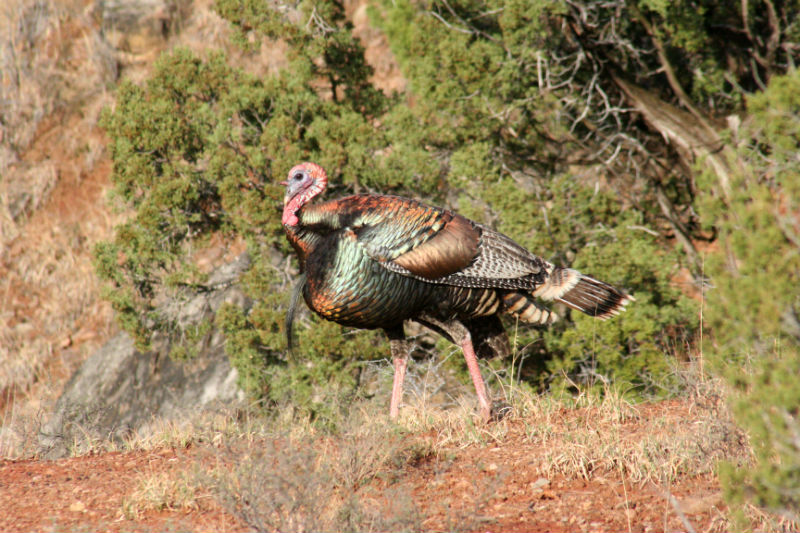After months of waiting, it’s finally turkey time for 2014.
The spring Rio Grande turkey season kicked off Saturday in South Texas and begins March 29 in northern counties. Putting in scouting time is the most important thing you can do before going afield in search of filling even one turkey tag much less seeking multiple successes. The most important things to consider are finding roost locations and logical food and water sources, locating setup areas that allow for good concealment and multiple lines of long sight and finding travel routes that intersect these locations.
As with scouting, hunters should know as much about the quarry they’re chasing, and after studying up on various reports and discussing the issue with biologists and wildlife experts, and seeing the same things in the field, it leads to the conclusion that turkey behavior has a distinct biological component. Knowing why turkeys do some of the things they do is another way to put in your homework and examine a number of scenarios before you head out.
Here’s a glance at the seasons within a turkey season, and why gobbling picks up in two of them, a notable aspect for hunters looking to fill a tag.
Early season: The beginning of the spring turkey season, regardless of whether it’s in the eastern Panhandle, the Hill Country or deep South Texas, is much like fall bass fishing: It’s a transition time. Around the middle to end of March and even into the middle of April in northern locales, turkeys will break up from larger winter flocks and gobbling activity spikes. Birds will move away from locales where they previously spent a lot of time and seek out breeding areas. This typically occurs in the same locations where they have constructed nests, which can play into your favor if you keep track of where you bagged a bird the previous year.
During the early season I’ve seen and heard amazing activity from toms and hens, including fighting and general cutting up, and it’s not unusual to hear hens being more vocal, too. The reason for this behavior has been linked by biologists to being a result of the uncertainty and very nature of birds that have broken off from flocks where they had spent lots of time.
If there’s one thing I’ve learned from hunting turkeys, it’s that familiarity makes them feel most safe, and when they don’t have the security of other birds for whatever reason they often will go silent, which means tougher hunting.
The dynamic for the season usually is set early and dominant gobblers looking to breed will cut out hens, leaving subordinates ripe for the plucking, especially younger toms and jakes that usually will come running to your calls. It’s not unusual to see large groups of jakes and subordinate toms hanging around the boss gobblers and their hens, which makes locating birds easier in the early season, especially if you can find roost sites. This is where safety in groups plays the largest role, and before birds begin to break off into even smaller flocks as the season progresses is one of your best bets to bring home a nice one.

Midseason: During the middle to end of April in much of Texas — and earlier in South Texas — a gradual change begins, and gobbling and loud behavior that was present even days before slowly tails off. Biologically, the birds have established their dominance or lack thereof and the challenging nature of birds in the early season gives way to less aggressive tendencies, especially as the pecking order is set.
Gobblers typically stay close to hens all day and roost near them at night, and birds that are this henned-up are almost impossible to lure away from harems. The toughest aspect about this part of the season is that toms will respond to calls a majority of the time, but they simply won’t break free from hens they’ve found. Even if you try to tempt them with sweet talk or challenge them with raucous gobbles they often end up following their harems whatever direction they feel like going — usually the other way.
One way you can swing things in your favor is to consider another aspect of turkey biology involving hens. As the middle of the season wears on, hens typically begin to visit their nests during late morning to lay eggs after breaking apart from toms at daybreak.
This precisely is why changing your tactics and hunting later in the morning and into the afternoon can mean the difference between bagging a bird and coming back empty-handed.
Late season: This portion of the turkey framework sees another peak in gobbling activity, and like many hunters, this is my favorite time to hunt. The biological aspect during this time of year to consider is the fact that this period sees most hens on nests incubating their clutches of eggs, while gobblers are left to roam in search of other hens to breed with.
This is the magic time, though there are some things to think about that could make things tough. The first is that there simply will be fewer gobblers and the ones left will have heard myriad calls, especially if you’re hunting public lands. These birds also may have ended breeding activity before the season is over, meaning your calling will fall on deaf ears. In this case, targeting food sources and setting up an ambush likely is your best play, especially as hungry toms that have eaten little during breeding season look to replenish themselves.
Hunting has the potential to be tough this season, but there’s no better time to enjoy a spring morning, afternoon and evening. It still will be rewarding, with or without filling your tags.



















